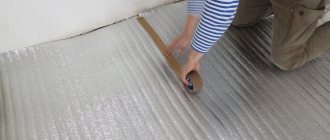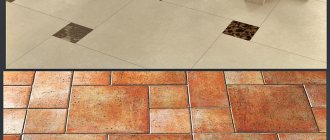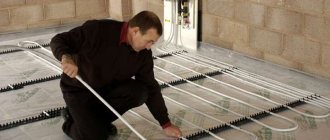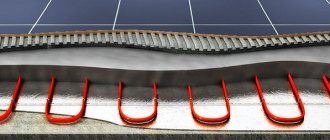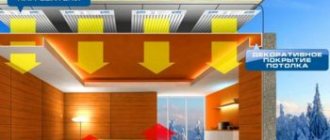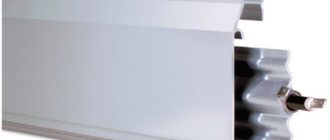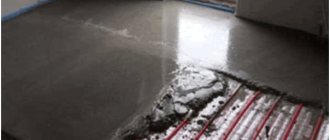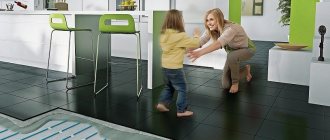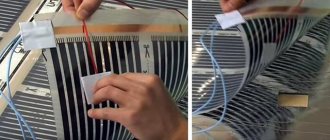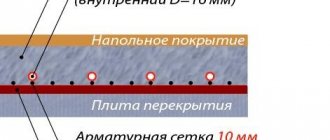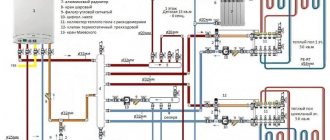In search of a more efficient heating system, people have tried many options, of which underfloor heating has become the most successful. Warm floors are usually installed during housing construction or renovation, since its installation requires a complete change in the heating system and floor structure. The advantage of this heating system is the large heat-transferring surface area. Let us examine in detail the delights of heating a house with warm floors.
Electric heated floor
Installation of electric heated floors can begin at any time during repair work. According to the type of heating, electric heated floors are divided into cable, thermomats (heating mats) and film. Heating occurs using a cable or any other heating device by supplying electricity.
The underfloor heating cable can be considered as the main heating system. But due to the high cost of electricity, it is most often used in small areas (bathtub, corridor), where it serves as the main heating.
Water heated floor
A type of underfloor heating that can be equipped with an autonomous water boiler or central heating (using a special heat exchanger). Does not work without a pump and requires one.
In addition to pipes, a water heated floor includes: thermal insulation (expanded polystyrene), damper tape, fasteners, special accessories for making expansion joints, as well as the manifolds with fittings necessary to connect the underfloor heating system to the heating system.
Thanks to its water component, it can operate from any boiler and does not depend strictly on electricity. Not counting the operation of the pumps themselves. An excellent solid heating system for your home.
Types of underfloor heating
There are 3 types of underfloor heating, which can be installed both in a private house and in an apartment. But not everyone is productive. In this regard, only one of them stands out. The rest are used as additional heating of the room:
- heated floor from central heating. Installation of electric floors can be carried out at any time during renovation activities. According to the type of heating, electric heated floors are divided into cable, heating mats and film. Heating is carried out using a wire or any other heating element by supplying electricity. The electric floor wire can be considered as the main heating system. But due to the high cost of electricity, it is most often used in small areas, where it serves as the main heating;
- IR heated floor. These are carbon fiber strips, the thickness of which is no more than 0.5 mm. IR film is placed under any floor base and acts as a comfortable heating system. It is very pleasant to walk on such a film, but there are few profits. Can be used in the off-season as the main heating system;
- water-based heated floor. A type of underfloor heating that can be equipped with an uninterrupted water boiler or central heating. Does not function without a pump and requires its constant use. A water heated floor, in addition to pipes, consists of thermal insulation, damper tape, fixing parts, special accessories for installing expansion joints, as well as manifolds with fittings necessary for connecting the floor heating system to the heating system. Thanks to its water base, such a floor can operate from any boiler and does not depend on electricity. Except for the operation of the pumps themselves. The ideal heating system for your home.
Water heated floor
Myths about heated floors
Is underfloor heating harmful to health? The peculiarity of heating a house with heated floors is that it is picky about installation technology. Failure to comply with the technology significantly affects the performance of the system. This is where myths regarding the dangers of heated floors are born.
If you install the floors correctly, then you don’t have to worry about any consequences.
Regarding electromagnetic radiation when installing an electric heated floor, many myths have also been born about it. Yes, indeed, like any electrical device, radiation occurs, but the intensity is so low that even insects will not notice your heated floor.
Heating a house with a warm water floor
When discussing the features of heating a house with a water floor, many developers are interested in factors that we will explain below.
System life
Manufacturers like to mention that underfloor heating can last at least 50 years. Underfloor heating pipes are designed for this period. Regarding external parts: manifold, taps, etc., most likely they will fail sooner. But changing them won't be a big problem.
Our experience suggests that buildings from 1996 to this day are doing quite well and the underfloor heating system works without problems.
System efficiency
Manufacturers often like to mention that heating a house with underfloor heating as the main source of heat is more economical than many other heating systems. As practice shows, in most cases you do not get significant savings. But condensing boilers, heat pumps and solar collectors (for additional heating) can be connected to heated floors. In these cases, flooring can be significantly more economical.
Comfort
Many developers are confused by the fact that the floor will be uncomfortable to walk on. It will also be uncomfortable to sleep at night. The surface temperature of the heated floor is only 28 degrees. You will practically not feel it. For the bedroom, you need to provide a room thermostat so that you can set a comfortable temperature.
Is it worth installing heated floors in a private house?
The pros and cons of heated floors will help you understand their need when planning construction. But comfortable conditions are worth spending money on installing a heating system. Heating the floor with an underground significantly reduces heat loss during cold periods and protects the walls of the house from destruction. Therefore, in private homes, installing floors is a good solution.
Experience shows that technical problems in this system occur quite rarely. Therefore, heated floors are considered reliable in use. The intricacies of installing such a device have already been sufficiently studied, so installing or repairing the equipment will not be difficult.
For your information!
As a modern heat source, a heat pump or condensing boiler is often used.
Warm floor or radiators. What's better?
Radiator heating has a number of advantages and disadvantages. The advantages of radiators are an affordable price for all segments of the population, a large selection, and widespread availability.
The disadvantages of radiator heating include the strictly horizontal installation of radiators, which contributes to irrational heat distribution. Warm floors warm a house much more evenly than radiators.
In terms of consumption, both systems will be comparable, but water heated floors are more expensive to install.
Having analyzed the advantages and disadvantages of both heating systems, we can conclude that the optimal option for heating a room is to combine radiator heating with a heated floor system. In this case, the advantages of both systems are combined, and their disadvantages are eliminated. The main advantage of using both heating systems is that they work autonomously from each other, and if one of the systems breaks down, you can use the second.
Disadvantages of water heated floors
- The heat loss of the room where the heated floor is installed must be less than 100 W/m2.
Conclusion: with higher heat losses, you will have to either insulate the house or install combined heating (water heated floor plus radiators). - It is not always possible to install water heated floors in apartment buildings with single-pipe heating systems. Well, or at least you need to know how to make such a connection correctly and without any conflicts with neighbors or utility workers (this is discussed in detail in the article about installing a water-heated floor in an apartment).
- Large thickness of concrete screed over a warm floor. If such heating is on the second floor or higher, then the floor level will rise by ~10 cm. On the first floor or on the ground floor, the total is more - by 14-20 cm. In other words, when planning heating with water-heated floors in an old apartment (house), be prepared to other global works related to the reinstallation of doors. And one more thing: concrete screeds for heated floors will increase the load on floors and other structures... are you sure they will withstand it? What is your confidence based on? Think about it.
- Installation of a water heated floor and materials for it are more expensive than for radiator heating. True, these expenses are then paid off by saving energy resources, as I wrote about above.
There are several more disadvantages of heated floors that must be taken into account. I will list them.
- Any warm floor (not necessarily water) is not the best heating system for rooms where people are constantly present. Surprised? I'll explain why. Alas, almost everything in the world has a downside.
So, contrary to the same well-known saying (or proverb? - I can’t remember what the difference is), your feet do not always need to be kept warm. I mean, not all the time! Blood rushes to heated areas of the body, this is well known to everyone. And the legs, being warm all the time, do not rest, the veins do not rest... The result is a disease of the veins due to their constant expansion.
Conclusion: you need to stay in a room with heated floors for a limited time. That is, do such heating in the hallway, bathroom, in any passage corridor, in the bathhouse, in the dressing room... where you are rarely or for a short time.
I mentioned the lack of mixing of air layers in the advantages of heated floors. But this is also a minus, because it is impossible to provide normal natural ventilation. But with radiators, natural ventilation is possible.
Conclusion: when designing heated floors, design forced ventilation with all its “delights” (connection to the power grid, noise, additional expenses... this is a continuation of the topic of efficiency), otherwise the air in such a room will be stale.
Not every material can be used to cover a warm floor. Therefore, you need to know the following.
It is necessary to distinguish between two concepts that are similar in sound, but different in meaning: “comfortable floor” and “warm floor”. What is the difference?
What is the difference?
The comfortable floor has a temperature of 20…22 degrees and is only suitable for off-season use. But in real winter cold it will not cope with heating. And then you will need additional heating (radiator, air, or something else). Wood is quite suitable for covering a comfortable floor.
But in a warm floor, the coolant heats up to 55 degrees. And you can’t cover such a floor with wood! Wood will crack due to high temperatures. But if you don’t heat it, then, again, such a heating system won’t cope in cold weather.
And although there is a separate section about coverings for heated floors, I will say a few words here. As coverings for heated floors, you need to take only natural materials: carpet made from natural material, ceramic tiles, linoleum - also from something natural, and not from PVC, parquet and parquet boards, etc.). Non-natural materials contain various harmful substances that will evaporate when heated... however, they evaporate even without heating. Do you need it?
Well, I believe that now, knowing all the pros and cons of water heated floors, you will be able to make an informed choice, and not “because that’s it.” Next, we will consider the issue of energy saving when heating with water heated floors.
heating with water heated floor
Underfloor heating scheme.
There are three main types of water floor installation.
Snail or spiral
The most popular, economical and energy efficient method of laying water heated floor pipes. The snail-shaped pipe laying scheme first describes the perimeter of the room, starting from the edge, and tends to the center of the room, constantly reducing the radius, and then in the opposite direction.
The advantage of this method is the step length - the snail can be mounted in steps from 10 mm to any convenient size. There is also an even distribution of heat. This method of laying a water heated floor pipe is the least labor-intensive due to the slight bending of the pipe. If you really want to, even one builder can handle the installation and you won’t have to spend money on additional labor. The method of laying pipes in the form of a snail allows you to install a heating system in rooms of any size and various shapes.
Advantages and disadvantages of underfloor heating as the main heating
The main advantage is comfort. A warm floor underfoot creates a feeling of warmth and comfort much faster than the hot air of a room. There are other advantages:
- Uniform heating of the room. Heat comes from the entire floor area, while the radiators partially warm the walls and distribute heat only to a certain area.
- The system operates completely silently.
- Since the heating elements are enclosed in the screed, heating has less impact on the humidity level.
- You can choose an option with different thermal inertia. The water floor slowly heats up and cools down for almost a day. IR film instantly heats the floor surface and cools just as quickly.
- Heating with water heated floors is cheaper than with radiators. The cost of electric heating is not so attractive.
- The systems are installed on the smallest platforms, even on staircases.
- The batteries do not decorate the room and do not fit into the interior. The heating elements of the heated floor are hidden from view.
Flaws:
- Installing a heated floor is a labor-intensive and lengthy process. Hydro- and thermal insulation is laid on the base base. Then reinforcement mesh or laying mats are placed. The pipes are positioned, connections are made, the concrete screed is poured, the underlay is laid and the finished floor is laid. This takes time and money.
- Water underfloor heating takes up at least 10 cm of height, and electric heating takes up from 3 to 5 cm.
- Repair is very complicated: in case of damage, it is necessary to remove the covering, break the screed, eliminate defects and re-lay the floor.
Method of laying pipes in the form of a snake
This scheme for laying water heated floor pipes has large heat losses due to the fact that hot water is supplied only from one side and loses all energy when reaching the end of the scheme. Thus, we get a warm floor at one end of the room and a gradual decrease in temperature as we move away from the coolant mixing unit. Another disadvantage of laying with a snake is the difficulty of installation. The pipe bends 180 degrees. Very often you have to take a step of 200 mm versus 10 for the snail.
In order to reduce the temperature difference in the snake system, you can make a double snake. However, this will not completely solve the problem of labor-intensive installation of water-heated floor pipes.
The best option for using a snake is to combine one method with the second. Or first you need to cut off the outer walls, then lay the snake in the middle of the room. This results in an optimal temperature distribution. A combined scheme involves mixing methods for laying heated floors or duplicating them. For example, two turns of a snail or several snakes in a row. If the layout of the room allows, then you can mix methods for laying out a warm water floor. For example, at the entrance, where heating is not particularly needed, put a snake, and in the center of the room, in order to concentrate useful energy, spread a snail. Before starting work, it is best to draw a diagram of the water heated floor on the plan. Thanks to this, future work on installing a water heated floor will become much easier.
Which gender is better to choose?
The choice of the best type of heated floor largely depends on the type and characteristics of the heated house; this should be taken into account when choosing a model
The thickness of the floor is important; for installing a water circuit - at least 7 cm, for an electric circuit - from 4 cm. When laying an infrared warm film floor, the thickness does not matter
In addition, you need to take into account:
- The power of the device is that water heaters heat the floor to a temperature of 50 degrees, while cable heaters have a heating range from 15 to 30 degrees.
- Costs for heating the coolant - electric floors require about 180 - 200 W of energy per 1 m2, and the floor warms up to only 30 degrees. The efficiency of a water system is much greater.
- Type of fuel - if the house is gasified, then preference should definitely be given to water heated floors. Setting up such heating is simple, cheap, and it is possible to control the temperature.
- The type of floor covering is an important point when choosing a heated floor model. The best option is ceramic tiles; they are suitable for all types of heated floors. Ideally, the floor covering should have a special marking that indicates the compatibility of the finishing material with the warm system.
When deciding on the type of heated floor for a private home, you must remember that installing a water circuit is a labor-intensive and dirty process. And if there is a concrete screed, it also takes a long time for it to harden.
If the installation of a heated floor in a private house is not planned at the construction stage or without major repairs, then it is best to choose an electric heated floor. And if you need a mobile device for laying under the carpet, mats or IR film are suitable.
However, for many, the decisive factor when choosing a warm electric or water floor for an apartment or house is the operating cost of the structure.
In conclusion, we can say that both types of heated floors have worked well. But for private houses with an individual heating boiler or gas, water heated floors are the best choice.
The final decision, of course, remains with the owner of the private home. You need to accept it based on your requirements for a given heating source, technical and financial capabilities.
However, it is better to purchase this or that model after consulting with a qualified technician and weighing data such as operational reliability and efficiency.
